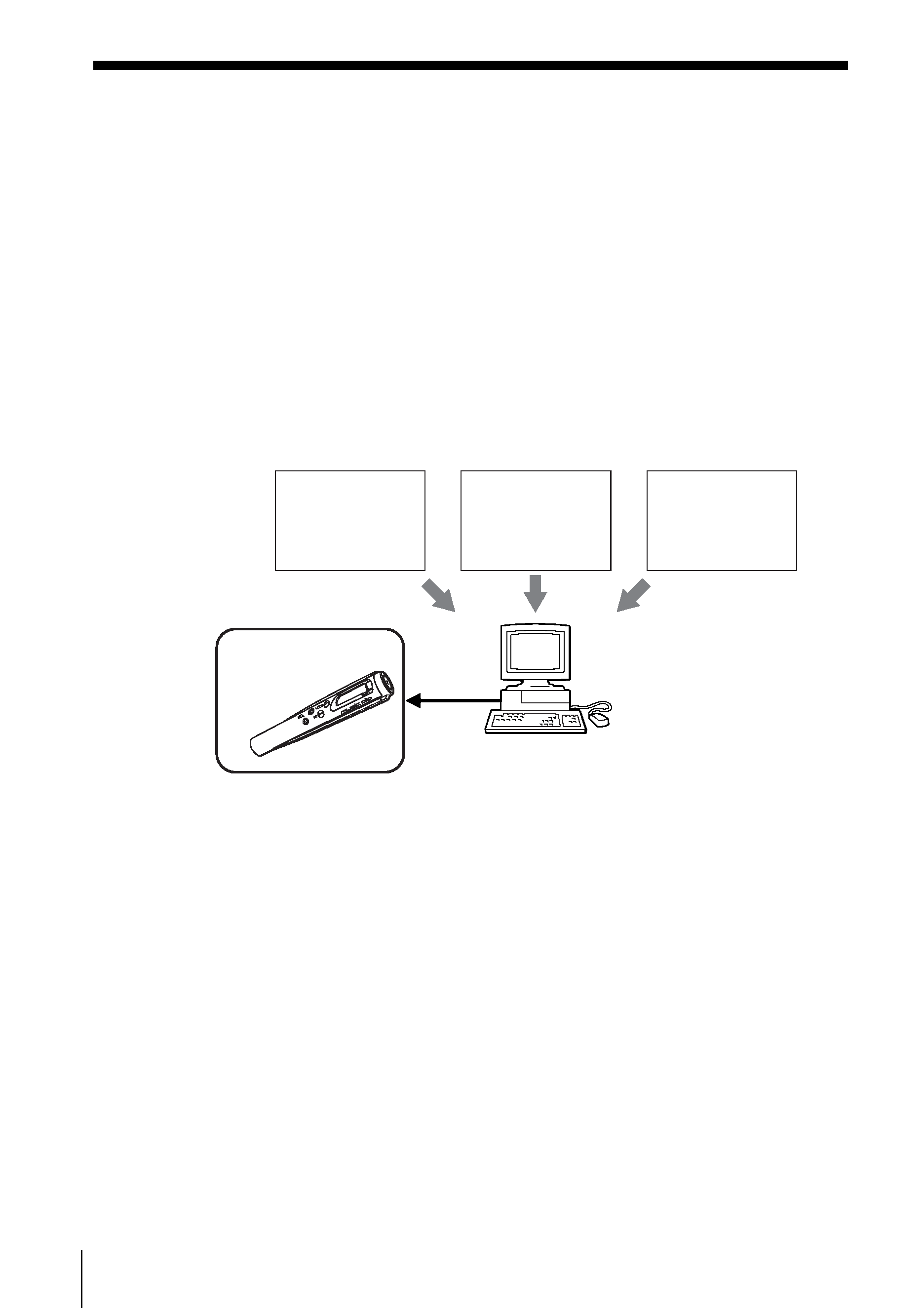
4-645-934-11(1)
©1999 Sony Corporation
MC-P10
Personal Network
Player
Operating Instructions

2
Owner's Record
The model is located on the battery compartment
lid and serial numbers are located inside of the
battery compartment. Record the serial number in
the space provided below. Refer to them
whenever you call upon your Sony dealer
regarding this product.
Model No. MC-P10
Serial No.______________
CAUTION
You are cautioned that any changes or
modifications not expressly approved in this
manual could void your authority to operate
this equipment.
NOTE:
This equipment has been tested and found to
comply with the limits for a Class B digital
device, pursuant to Part 15 of the FCC Rules.
These limits are designed to provide
reasonable protection against harmful
interference in a residential installation. This
equipment generates, uses, and can radiate
radio frequency energy and, if not installed
and used in accordance with the instructions,
may cause harmful interference to radio
communications. However, there is no
guarantee that interference will not occur in a
particular installation. If this equipment does
cause harmful interference to radio or
television reception, which can be determined
by turning the equipment off and on, the user
is encouraged to try to correct the interference
using one or more of the following measures:
Reorient or relocate the receiving antenna.
Increase the separation between the
equipment and receiver.
Connect the equipment into an outlet on a
circuit different from that to which the
receiver is connected.
Consult the dealer or an experienced
radio/TV technician for help.
Declaration of Conformity
Trade Name: SONY
Model No.: MC-P10
Responsible Party: Sony Electronics Inc.
Address: 1 Sony Drive,
Park Ridge, NJ 07656 USA
Telephone No.: 201-930-6970
This device complies with part 15 of the FCC Rules.
Operation is subject to the following two
conditions:
(1) This device may not cause harmful
interference, and
(2) this device must accept any interference
received, including interference that may cause
undesired operation.
Program
© 1999 Sony Corporation
Documentation
© 1999 Sony Corporation
Sony, VAIO and the VAIO logo, Music Clip,
OpenMG and the OpenMG logo are trademarks
of Sony Corporation.
IBM and PC/AT are registered trademarks of
International Business Machines Corporation.
Microsoft, Windows and the Windows 98 logo
are registered trademarks of Microsoft
Corporation.
MMX and Pentium are registered trademarks of
Intel Corporation.
CD-related data through the Internet from the
CDDB
TM Music CD Database.
Copyright
© 1999 CDDB Inc. CDDB Client
Software. Copyright
© 1999 CDDB Inc.
CDDB-Enabled
TM, CDDBTM, CDDB 2TM and the
CDDB Logo are trademarks of CDDB, Inc.
All other trademarks are trademarks of their
respective owners.
Notes
· The recorded music is limited to private use
only. Use of the music beyond this limit
requires permission of the copyright holders.
· Sony is not responsible for music files that
are not saved on your computer due to
unsuccessful CD Record or EMD
downloading.
· Your Music Clip and associated OpenMG
software is not equipped with a Back-up/
Restore function. Sony is not responsible
for deletion of music files from your
computer during a system crash or while
you restore your computer's hard disk
using the recovery CD(s).
On the supplied software
· Copyright laws prohibit reproducing the software
or the manual accompanying it in whole or in part,
or renting the software without the permission of
the copyright holder.
· In no event will SONY be liable for any financial
damage, or loss of profits, including claims made
by third parties, arising out of the use of the
software supplied with this player.
· In the event a problem occurs with this
software as a result of defective
manufacturing, SONY will replace it.
However, SONY bears no other responsibility.
· The software provided with this player cannot
be used with equipment other than that which
is so designated.
· Please note that, due to continued efforts to
improve quality, the software specifications
may be changed without notice.
· Operation of this player with software other than
that provided is not covered by the warranty.

3
Table of contents
Overview 4
What you can do with the Music
Clip
TM Personal Network
Player 4
Copyright protection 5
System requirements 6
About this manual 7
Using the OpenMG Jukebox Help
7
Getting started
Unpacking 8
Parts and Controls 9
Installing the OpenMG Jukebox 10
Uninstalling the OpenMG Jukebox
11
Inserting the battery 12
Using the neck strap 13
Basic operation
Using the Music Clip Player 14
Connecting the Music Clip Player
to your computer 14
Starting the OpenMG Jukebox 14
OpenMG Jukebox basic controls 14
Recording a CD on your computer
16
Transferring the songs to the
Music Clip Player (Check out)
17
Playing songs on the Music Clip
Player 18
Using the display information 19
Additional operations
Playing songs repeatedly (MODE)
20
Changing the equalizer (EQ) 21
Limiting the maximum volume level
with Auto Volume Limiter
System (AVLS) 22
Locking controls (Hold) 22
Additional information
Precautions 23
Specifications 24
Getting Help 25
Troubleshooting 26
Frequently Asked Questions
(FAQs) 27
Restrictions on the copyright
protection by OpenMG 29
Terminology 31
Limited Warranty Statement 33
Index 38

4
Overview
What you can do with the Music Clip
TM Personal
Network Player
The Music Clip Player is a portable audio player that allows you to
easily transfer digital sound data from your computer to the Music Clip
Player.
The OpenMG
TM technology allows you to enjoy digital music, while
maintaining the copyrights of its holders.
The OpenMG-compliant application software that is supplied with
your Music Clip Player enables you to store digital music data on your
computer's hard disk and transfer it to the Music Clip Player.
The supplied OpenMG Jukebox software allows you to import digital
sound data as follows:
downloads sound data provided by Electronic Music Distribution
(EMD) services over digital networks such as the Internet,
records audio CDs onto the hard disk of your computer (the imported
songs are encoded in ATRAC3 or MP3 format),
converts the existing MP3 and WAV format audio files into OpenMG
format. (WAV format audio files are converted into ATRAC3 format,
and MP3 format audio files are converted into ATRAC3 format or
encoded without changing the format.)
The OpenMG Jukebox encrypts sound data in OpenMG format and
stores it on the hard disk of your computer to prevent unauthorized
distribution.
The copyright protection technology of the Music Clip Player conforms
to the SDMI (Secure Digital Music Initiative) specifications.
EMD services
WAV3, MP3
files
Audio CDs
Music Clip
Player
USB
connection
Hard disk of your
computer (OpenMG
Jukebox)

5
Copyright protection
The Music Clip Player has some restrictions on recording and playback
to protect copyrights.
For details, see "Restrictions on the copyright protection by OpenMG"
on page 29.
What is OpenMG?
OpenMG is a copyright protection technology used when recording
and playing back audio data on computers. OpenMG encrypts and
saves digital audio data on a computer's hard disk, and allows the
audio data to be played back on that computer only, protecting it from
being illegally delivered over a network.
Transfer of sound data from your computer to the Music
Clip Player (Check in/out)
The supplied application software (OpenMG Jukebox) enables you to
transfer the sound data stored on your computer's hard disk to the
Music Clip Player (Check out) and transfer it from the Music Clip
Player to your computer (Check in).
Check in/out restrictions:
You cannot check out the same song more than three times (excluding
certain songs). However, if you transfer a checked out song back to
your computer (Check in), you can then check out the song again.
You cannot check in songs checked out to the Music Clip Player to
any computer other than the computer used for the Check out.
For details, see "Terminology" on page 31.
Restrictions on sound data
Some sound data is distributed with restrictions on recording or
playback of the data to maintain of its holders' copyright.
For example, songs which have playback period restrictions can be
played back only within the given period of time.
